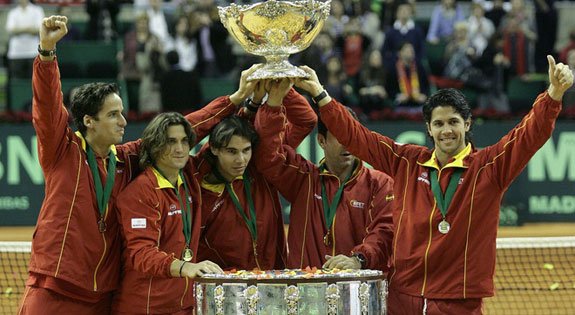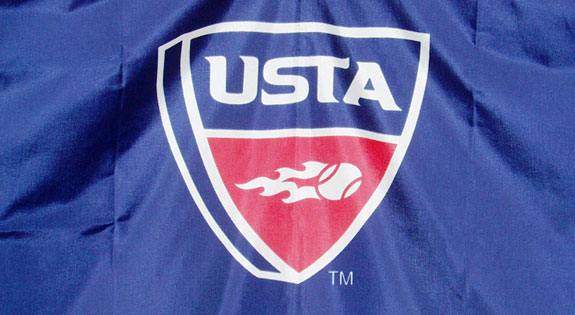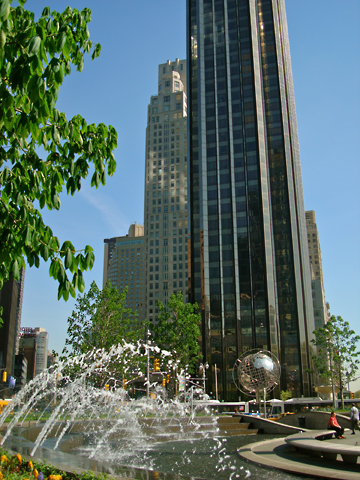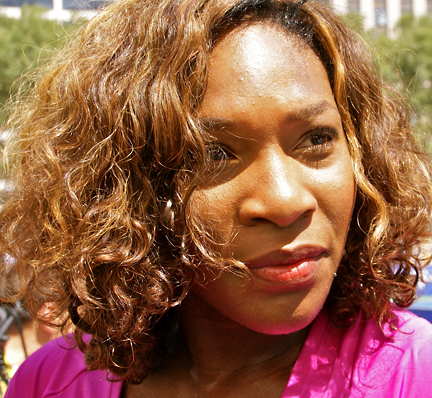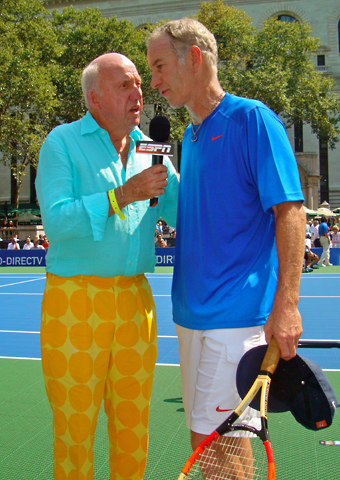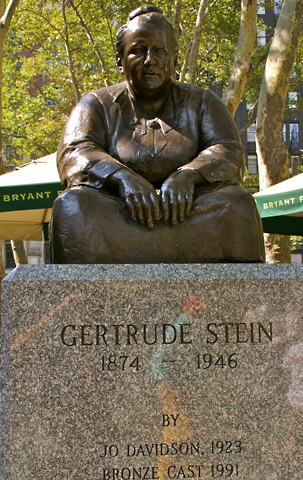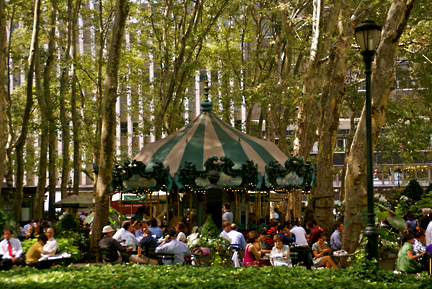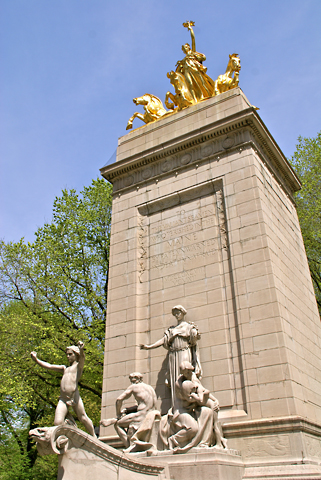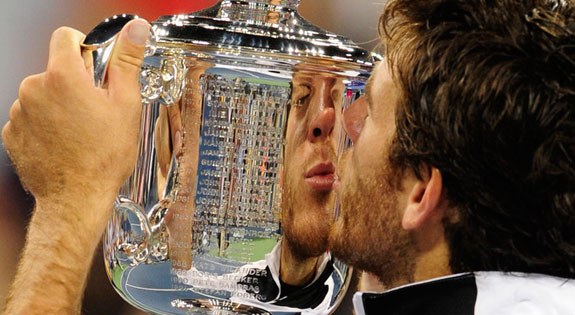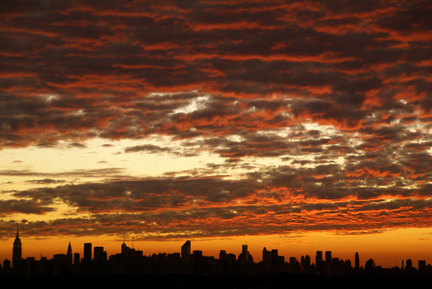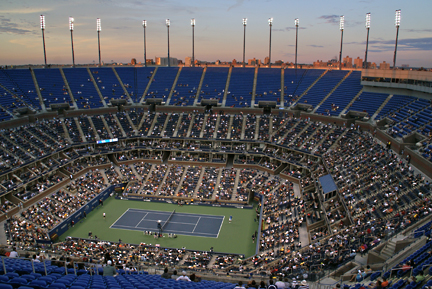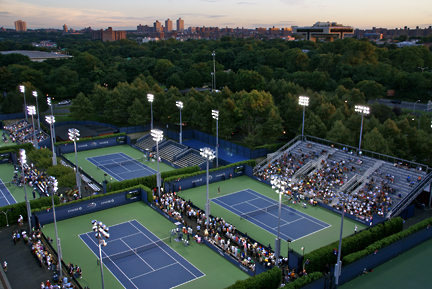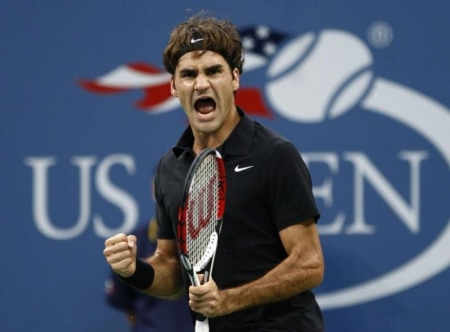Eleven years ago this week, Roger Federer was staking his claim as the top player in the world – in the juniors. Federer ended his junior career by winning the 1998 Orange Bowl in Key Biscayne, Fla. The win placed him in the No. 1 ranking in the International Tennis Federation junior rankings for the first time. However, he would not clinch the year-end No. 1 junior ranking until later, when a future rival, as you will read below, helped cement his year-end No. 1 ranking. The following is an excerpt from the book THE ROGER FEDERER STORY: QUEST FOR PERFECTION by Rene Stauffer ($24.95, New Chapter Press, www.RogerFedererBook.com) that outlines Federer’s last year as a junior.
The year 1998 began auspiciously for Roger Federer. He started the year winning the Victorian Junior Championships in Australia. He narrowly missed reaching the junior singles final at the Australian Open, botching a match point in losing to Sweden’s Andreas Vinciguerra in the semifinals.
During the following spring and summer, he showed that he was a confirmed all-around player who could win on any surface. He was well ahead of any player in his age class internationally. He competed effortlessly at the highest level of international junior tennis—primarily against players who were one year to 18 months older than him. In the clay court season, he won the international junior title in Florence, Italy, but at Roland Garros in Paris, he was defeated in the first round.
At Wimbledon, Federer celebrated his greatest triumph to that point in his career. On July 5, he defeated Irakli Labadze from the Republic of Georgia 6-4, 6-4 to win the Wimbledon junior singles championship, becoming the first player to win the title from Switzerland since Heinz Günthardt in 1976. In fact, Federer did not lose a match for the week on the grass courts of southwest London as he also won the junior doubles title with Olivier Rochus from Belgium. “I felt satisfied but not overjoyed,” said Federer, who was astonishingly unimpressed. But Peter Carter, who was almost always with him, was enthused. “Roger played with the concentration of a professional,” he said. “Now he just has to improve his volleys.”
A little chaos, however, followed the big victory. As a reward for winning the Wimbledon junior title, Federer received a wild card entry into the Swiss Open in Gstaad from tournament director Köbi Hermenjat. Federer received his first chance to play in an ATP tournament, even though he was not qualified to play since his world ranking stood at No. 702. Gstaad, the clay court tournament that traditionally takes place the week after Wimbledon, is played in a picturesque jet-set vacation area in the Bernese Alps. It is one of the oldest professional tournaments with a history dating back to 1915. It is loved by players and spectators alike because of its idyllic location in the little village with many chalets, the majestic Palace Hotel—whose courts previously hosted the tournament—and its postcard ambiance. Hermenjat was one of the most senior tournament directors on the ATP Tour and well-acquainted with everyone in the tennis world. He embodied a piece of tennis history. He was a ball boy for the tournament when he was 11 years old and had been the tournament director since 1965. Tennis legends such as John Newcombe, Tony Roche, Ilie Nastase, Ken Rosewall and Roy Emerson—after whom later the Centre Court was named—are all past champions of the Swiss Open.
Federer very reluctantly declined taking part in the traditional and prestigious Wimbledon Champions Dinner and left London that Sunday. He flew to Basel and continued by automobile to the Bernese Alps. It was well after midnight when he arrived at the luxury resort.
Federer’s ATP tournament debut proved difficult. At Wimbledon, he played on grass courts and almost at sea level. In Gstaad, he found himself on slippery clay courts and at over 3,000 feet above sea level. At Wimbledon, the balls bounced low, but in the high air at Gstaad, the balls bounced high and fast. The clay surface also demanded a completely different running technique than on grass. At Wimbledon, he competed against inexperienced junior players. An array of world class players were in the draw at Gstaad. There was no doubt that the tournament was a few sizes too big for him. His purpose, however, was just to gather some experience and be presented, on this grander sporting stage, to a larger portion of the Swiss public.
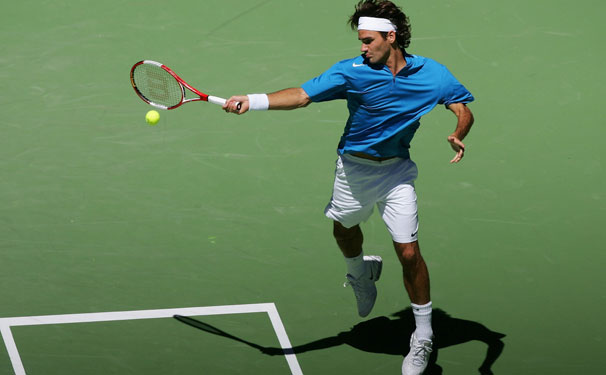
Federer drew German Tommy Haas, ranked No. 41 in the world rankings, as his first-round opponent, scheduled to play on Tuesday, the second day of the tournament. On Monday, due to great demand, Federer held a press conference to discuss his Wimbledon junior success and his ATP debut. “I would have preferred to play on the Centre Court than on the secondary court,” he said confidently of where the Gstaad tournament officials chose to schedule his match. There was so much interest in the Wimbledon junior champion that the thousand seats in the grandstands at Court No. 1 in Gstaad were not enough to accommodate the storm of spectators. As it turned out, Tommy Haas was not Federer’s opponent. The German withdrew from the tournament a few minutes before match time due to stomach trouble. Lucas Arnold, a lucky loser from the qualifying tournament, was Federer’s opponent. The Argentine clay court expert, ranked No. 88 in the world, defeated Federer 6-4, 6-4, but Arnold admitted that he was impressed by the 16-year-old, saying “he plays like Pete Sampras and he has a great serve.”
Federer was disappointed but he had no reason to be crushed. “I competed very hard, but did not play well. If I had played well, I would have won,” he said in an upbeat tone. “You have to do more running with the professionals than with the juniors and pros are not going to make as many mistakes.”
Stéphane Oberer, the Swiss Davis Cup team captain, technical director of the Swiss Tennis Federation and Marc Rosset’s long-time coach, also was in Gstaad and witnessed Federer’s ATP match debut. Oberer recognized Federer’s talent and pulled strings in the background to mentor him. “Roger was still playing like a junior,” Oberer said in Gstaad. “Individual points were of little value to him but he has everything to become a champion one day. We just had to be careful not to burn him out. It wasn’t important that he was strong for now but that he could realize his potential in four to six years.”
Oberer gave Federer the opportunity to accompany the Davis Cup team as a practice partner, where he was able to train with the team in the first round against the Czech Republic in Zurich in April. Following the tournament in Gstaad, Federer again traveled with the team to La Coruna, Spain for the Davis Cup quarterfinal with Spain. Even though the Swiss didn’t stand a chance against the Spanish Armada of Carlos Moya and Alex Corretja, the trip proved to be a valuable learning experience.
Federer wanted to finish the year as the No. 1 ranked junior in the world. After his triumph at Wimbledon, he was ranked No. 3 behind France’s Julien Jeanpierre and the Chilean Fernando Gonzalez. Everybody knew that it was a major difference if he finished the year No. 1 against being ranked No. 2 or No. 3. As with professional tennis, the best junior players are over-proportionally rewarded—the No. 1 players get better contracts and more wild card entries into big tournaments. The wild card entries spared the select players from the difficultly and unpredictable nature of qualifying tournaments. Wild cards provided an opportunity for young players to compete in bigger tournaments that they would not be able to gain entry into due to their lower world rankings.
Federer bolstered his quest for the year-end No. 1 junior ranking with a semifinal showing at the European Championships in Klosters, Switzerland in the summer. At the US Open, he reached the junior singles final, where David Nalbandian of Argentina denied him a second straight junior Grand Slam title.
Yet, before the chase for the year-end No. 1 junior ranking reached its decisive phase, the unexpected happened. Federer achieved his first great breakthrough on the ATP Tour. With a ranking of No. 878, he traveled to Toulouse, France at the end of September and, to his own surprise, advanced through the qualifying rounds to progress into the main draw of the tournament. In only his second ATP tournament, the 17-year-old registered an upset victory over No. 45-ranked Guillaume Raoux of France—his first ATP match victory—allowing the Frenchman just four games. In the next round, Federer proved this win was not a fluke by defeating former Australian Davis Cup star Richard Fromberg 6-1, 7-6 (5). In the quarterfinals—his sixth match of the tournament including matches in the qualifying rounds—Federer lost to Jan Siemerink 7-6 (5), 6-2, with a throbbing thigh injury hampering him during the match. The Dutchman was ranked No. 20 and went on to win the tournament two days later, but Federer was also handsomely rewarded. He received a prize money check for $10,800 and passed 482 players in the world rankings in one tournament—moving to No. 396.
In recognition for his results in Toulouse, Federer received a wild card entry into the Swiss Indoors, Switzerland’s biggest tournament, from tournament director Roger Brennwald. This tournament guaranteed him a prize money paycheck of at least $9,800. The tournament took place at St. Jakobshalle in Basel’s south side, within walking distance of Federer’s home in Münchenstein. This event, played originally in an inflatable dome in 1970, is one of the most important indoor tournaments in the world that almost every great player has played in. When a virtually unknown Czech player named Ivan Lendl defeated the legendary Björn Borg in the Swiss Indoor final in 1980, it garnered major headlines around the world. The 34th and final duel between John McEnroe and Jimmy Connors took place at the Swiss Indoors in 1991. Future world No. 1 Jim Courier won his first ATP tournament in Basel in 1989. Stefan Edberg won the Swiss Indoors three times and Ivan Lendl won the title twice. Borg, McEnroe, Boris Becker, Vitas Gerulaitis, Goran Ivanisevic, Yannick Noah, Michael Stich, Pete Sampras and Guillermo Vilas are also champions of the event.
For Roger Federer, the Swiss Indoors is like a Grand Slam tournament. The St. Jakobshalle is the place of his dreams, like Centre Court at Wimbledon. In 1994, he was a ball boy at the event, grabbing balls for such players as Rosset, Edberg and Wayne Ferreira, who won the title back then. Now, four years later, he was a competitor in the event. His first-round match was against none other than Andre Agassi. In his youthful hauteur, Federer boldly stated “I know what I’m up against—as opposed to Agassi who has no idea who I am. I am going to play to win.”
But Agassi, the former No. 1 player ranked No. 8 at the time, was without question a larger caliber opponent than what Federer faced in Toulouse. Agassi allowed the hometown boy only five games in the 6-3, 6-2 defeat and said he was not overly impressed by the Swiss public’s new darling. “He proved his talent and his instinct for the game a few times,” the American said kindly. “But for me it was an ideal first round where I didn’t have to do all that much and where I could get accustomed to the new conditions.”
After appearances in big events in Toulouse and Basel, Federer next competed on the much lower level Swiss satellite circuit—and felt as if he were in a bad movie. He just played before 9,000 spectators against Agassi, one of the all-time greats, in front of a major television audience with all the newspapers writing articles about him. Meanwhile, he just signed with the world’s largest sports agency, International Management Group, and was being supplied, like Pete Sampras, by brands such as Nike and Wilson. But now he suddenly found himself in the eastern Swiss town of Küblis, in a gloomy tennis stadium in a valley wedged in the Bündner Mountains. There were no spectators, no line judges and no ball boys. He was not facing Andre Agassi, but Armando Brunold, the No. 11 player in Switzerland, whom Federer by now outclassed as the No. 6 player in the country.
The first-round match at the circuit’s first tournament proved to be a culture shock for Federer and he reacted apathetically. His listlessness didn’t escape tournament referee Claudio Grether. “He simply stood unmotivated and non-chalantly on the court and double-faulted twice each game,” Grether explained. After Federer lost to Brunold 7-6, 6-2, Grether imposed a $100 fine against Federer because he violated the “best effort” rule stipulating that professional players must put forth their best efforts in every competition. “I could have disqualified him as well but then he would no longer have been able to compete in the rest of the circuit,” Grether said. Federer silently received the verdict. With prize money earnings of only $87, Federer left Küblis with a $13.00 deficit. It would be the only professional tournament he played where he actually lost money.
But Federer learned his lesson. “The fine was justified,” he admitted and he reacted in a way that showed his class. A week later, he won the second tournament on the circuit and went on to win the circuit’s overall points title. His effort paid off and despite his initial setback, he moved passed 100 opponents in the world rankings, landing at No. 303. Not bad for somebody who just turned 17.
As the Orange Bowl in Florida approached in December, it became clear that Federer would have to win the event—one of the biggest tournaments on the junior tennis calendar—if he wanted to overtake France’s Julien Jeanpierre—his senior by 17 months—and become the year-end No. 1 ranked junior in the world. The tournament took place in one of the most beautiful places on the tennis tour, The Tennis Center at Crandon Park on Key Biscayne—the island paradise within the shadow of downtown Miami. The second biggest tournament in the United States—the Sony Ericsson Open—is also held at the facility every March for which the grandstands at Centre Court are enlarged.
The tournament started off with a near disaster for Federer. After being just two points from defeat, he avoided a first-round upset bid by Raimonds Sproga of Latvia, winning by a 5-7, 7-6, 6-0 margin. By contrast, Jeanpierre was not as lucky and fell in the first round to Feliciano Lopez of Spain. The following day when Roger had the day off, another potential disaster presented itself. “We were condition training when Roger started horsing around,” recollected Annemarie Rüegg, who accompanied the Swiss team to the Orange Bowl. “He was acting like a monkey while jump-roping and was jumping around like Tarzan. Suddenly he landed sideways on his foot and sprained it. It looked bad. He had a giant swelling on his foot. He was abruptly jolted from his silliness.”
Another person in the same situation perhaps would have given up, abandoned his great goal, and pursued another one—but not him. “Roger Federer does not quit,” he said years later—and the same was true already in 1998. He began treatment with accompanying physiotherapists and did everything to preserve his chances to achieve his goal. “I was amazed at his metamorphosis,” said Rüegg. “Just before he was horsing around but now he was suddenly calm and serious. I noticed that he can be serious if he wants to be. He understood that it was a serious situation, that a lot was riding on the tournament, and that he had to concentrate all of his efforts on this one goal if he wanted to achieve it. I realized for the first time that he was a champion. He could do it.”
Despite the handicap and with a bandaged foot, Roger won the next three matches without losing a set. In the semifinals, with the swelling in his foot virtually gone, Federer avenged his US Open loss to Nalbandian with a 6-4, 6-2 victory. In the final, Federer defeated another strong Argentine, Guillermo Coria, 7-5, 6-3. Federer won the Orange Bowl and left Miami with a bowl full of oranges—and bleached-blond hair after a spontaneous $250 hair-styling adventure.
On December 21, 1998, for the first time, the name “Federer” appeared in the No. 1 position on the International Tennis Federation’s world junior rankings. “A great Christmas present,” he said happily. However, Federer still endured one more week of uncertainty until his year-end No. 1 ranking was official. It wasn’t until an upstart American junior named Andy Roddick defeated Jeanpierre in the semifinals of the last junior tournament of the year—the Yucatan Cup in Mexico—that Federer clinched the year-end No. 1 ranking.
At the end of his 1998 season, Federer sat for a comprehensive interview with Tages-Anzeiger in the lounge of the tennis facility in Diepoldsau during a Swiss satellite circuit. Curious players frequently drifted into the vicinity of the interview in an attempt to listen in to what was being discussed. Some players friendly with Federer even made jestful comments during the serious interview.
It was clear to Roger Federer that his time as a professional tennis player was about to begin. He exceeded all expectations as a junior and there was no reason for him to spend any more time on the junior or the satellite circuits. He was on the threshold of the top 300 in the world rankings and Stéphane Oberer, the Swiss Davis Cup captain, unequivocally told him that he was counting on him for the Swiss Davis Cup team in the coming year.
Federer viewed this rapid development with calm. He himself was somewhat surprised by his success but he remained grounded and seemed pleasantly normal. “It’s funny,” he said. “When I come into a hotel, people say ‘Hi, Mr. Federer.’ Some people seem to be proud to be able to speak to me. I’ve noticed that the more well-known one becomes, the less one has to pay. Everybody wants to invite me and everybody wants to be nice to me just because I can play tennis well.”
But he knows, he said, that these are not real friends. “I haven’t changed much,” he said. “I’m pretty well-known now in Switzerland but I don’t have the feeling of being a star.” When asked how to describe himself, he calmly answered. “I’m honest. I’m a cool type. I’m athletic and likeable, and pleasant, I think.”
Federer now stood at 6’1″ (1.86 meters) in height and weighed 175 lbs. (80 kilograms). This was too heavy, he believed. “I have a gut,” he said. “I should do more for my stomach muscles.” Sweets and snacks and eating properly became more of a priority. “I’ve just started to eat meat,” he said. “Before I only ate sausage, hamburgers and such. Now I don’t always have to be afraid to eat when I’m invited somewhere for a meal.”
He said he was also proud that he was now able to better maintain his emotions on the court. An incident at the US Open proved to be somewhat of a turning point. He was provoked by some of the US Open’s traditionally vocal fans. Federer could not keep his mouth shut and demolished a racquet in his frustrations. Federer kept his cool in the autumn tournaments—resulting in positive results. “I didn’t get upset at either Toulouse or Basel. That was very solid,” he said. “I never would have thought that it would have been possible, I don’t know if this has something to do with the big stadiums. Perhaps I’m more ashamed when I lose control there.”
He also engaged in fewer soliloquies during matches. “I often asked myself ‘Why are you so stupid and get upset?’ But when one plays well and doesn’t get upset, that’s the greatest feeling in the world.” After all, he said, he’s just a perfectionist. “I don’t accept it when I miss easy balls even if it is normal and even if the professionals do it.”
Peter Carter corroborated this mental progress; “He has to be more patient if he wants to be successful at the professional level.”
Carter and Federer were constant companions, training and traveling week after week. This sometimes led to friction in their relationship. “If I’m on tour for a month just with Peter, we sometimes get on each other’s nerves,” Federer said. “Then I miss my friends or my girlfriend. That’s why it’s important for me to get along well with other juniors. I like it when other Swiss players and coaches are around. That’s a change of pace I enjoy.”
He looked ahead to his first full year on the professional tour with confidence and excitement. He no longer found any great weaknesses in his game. “I have slowly come to master all the strokes,” he said. “I could perhaps volley better or improve my footwork, little things.”
What did he have to worry about? He had, after all, defeated two top 50 players in Toulouse “That showed me that I could compete up there if I played well,” he said. “Now I just have to work on making it run smoothly. Then getting to the top should take care of itself.”

